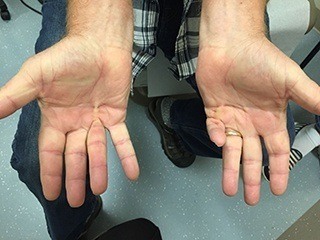Dupuytren’s contracture

Dupuytren’s disease is a disorder of thickened fascia in the palm from excess deposition of collagen. This results in the development of nodules or cords in the palm, which, if severe enough can cause an inability to fully straighten the fingers. The ring and small fingers are most commonly affected.
The cause of this disorder is unknown. It is seen more commonly in men and is usually found in individuals of Northern European descent. There are some risk factors to developing Dupuytren’s disease including diabetes, alcoholism, seizure disorders, and liver cirrhosis.
If the disease is limited to nodules, or the deformity is mild and there is no functional loss, no treatment is needed. If, however, there is significant contracture that interferes with functional use of the hand, there is treatment available to correct the deformity. Traditionally, open surgery is performed through a zigzag incision, to remove the diseased palmar fascia. This is followed by a period of therapy to help manage the scar tissue and to regain full motion of the finger. Alternatively, the diseased tissue can be chemically removed using an injection of an enzyme called collagenase. The enzyme is injected into the cord, and 1-2 days later, the finger is manipulated and straightened. There is no incision involved, and usually no therapy involved. How long the results last is not yet known. Another treatment option called needle aponeurotomy, can potentially be performed in an office setting. Local anesthesia is instilled in the skin overlying the cord. Then a small needle is used to fenestrate (poke holes, essentially) in multiple areas of the cord to weaken the cord. The finger is then manually manipulated to straighten the finger. This treatment can be very successful in correcting the contracture. However, following needle aponeurotomy, the contracture does tend to recur, usually within 1-3 years, at which time, the procedure may be repeated if needed. Sometimes, needle aponeurotomy is performed in very severe contractures, as a pre-surgical procedure, to make open surgery easier and safer. This type of treatment has some limitations, and there are associated risks. Dr. Yu will discuss all of these with you, so that you may choose the most appropriate treatment for your hand.
Read more:




